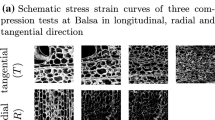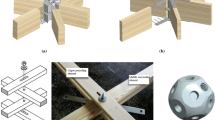Summary
This paper describes a modelling approach to predict the behaviour of an elementary thin timber bolted joint. The application concerns principally joints with steel side members; bolts have a constant 12 mm diameter with two ratios of end distance to bolt diameter and two bolt clearances. The behaviour of the bolted joints is characterized by a double non linearity; the first one is due to the contact area evolution between the bolt and the hole of the jointed elements. The second one is owing to the evolution of plasticity on the wood. A spring element compatible with isoparametric plane finite elements represents the contact evolution. The elastic-plastic wood is provided with a plastic flow rule according to the Tsaï criterion. This study allows an investigation on the parameters characterizing the Tsaï criterion, particularly F12 which represents the interaction between the principal axis of orthotropy. A two-dimensional model is used. It permits the assessment of the clearance bolt, joint dimensions, wood plasticity and wood grain angle effect on the joint behaviour. The wood grain angle has a non negligible effect on the plastic strains distribution and it can create a parasite loading because the joint tends to rotate even for an axial loading. The results showed a good agreement between experimental values given by some authors and numerically-predicted stresses on the joint. So, the applications concern a two-dimensional joint with anisotropic plastic material. The generalization in the three-dimensional modelling is desirable to take into account the interaction between the wood and a metallic fastener in thick joints with different geometric characteristics.
Similar content being viewed by others
Abbreviations
- d:
-
bolt diameter
- φ, phi:
-
hole diameter
- Ex :
-
elastic modulus — longitudinal direction (grain direction)
- Ey :
-
elastic modulus — transversal direction (radial or tangential)
- G(XY) :
-
stiffness shear modulus —XY plane
- V(XY) :
-
Poisson's ratio — XY plane, loading on X-direction
- σx, σy :
-
wood tensile strengths, in the longitudinal and transversal directions
- σ′X, σ′Y :
-
wood compressive strengths, in the longitudinal and transversal directions
- τxy :
-
wood shear strength on the XY plane
- θ:
-
wood grain angle
- dσ:
-
effective stress increment in the general set of axis
- dσe :
-
increment of stress assumed to be elastic
- [D]:
-
matrix of elastic constants
- Y:
-
Tsaï equivalent stress (=1 without strain hardening)
- dλ:
-
plastic multiplier
- F(σ):
-
Tsaï as a flow plastic criterion
- dS:
-
effective stress increment in the matrix [W] eigenvectors set of axis
- dSe :
-
Increment of stress assumed to be elastic according to the eigenvectors of [W]
- Xi :
-
eigenvalues of the matrix: [W] = [D] [M]
- [Φ]:
-
matrix of eigenvectors of [W]
- [I]:
-
unit matrix
- k:
-
strain hardening parameter
- a:
-
end distance of the joint
- b:
-
half-width of the joint
- CASTEM:
-
finite element program for structural analysis (CISI-CEA)
- INCA:
-
program of CASTEM for two-dimensional mechanical and thermal problems
References
ASCE Committee on Wood. 1986: Structural Wood Research Needs, J. Struc. Eng., 112(9): 2155–2165
Bodig, J.; Goodman, R. 1973: Prediction of elastic parameters for wood, Wood Science, 5(4): 249–264
Bodig, J.; Jayne, B. A. 1982: Mechanics of wood and wood composites, Van Nostrand Reinhold Company Inc., New York, pp. 712
Bouchair, A. 1993: Modélisation non linéaire du comportement local des assemblages bois, Thèse de Doctorat, Université Biaise Pascal, Clermont-Ferrand, pp. 272
Chen, W. F. 1982: Plasticity in reinforced concrete, McGraw-Hill Edit., New York, pp. 474
Combescure, A. 1986: Strategies for non-linear static calculations, ISPRA courses, pp. 20
François, P. 1992: Plasticité du bois en compression multiaxiale, application à l'absorption d'énergie mécanique, Thèse de Doctorat, Université Bordeaux I, pp. 107
Gautherin, M. T. 1980: Critère de contrainte limite du bois massifThèse de Doctorat 3e cycle, Université Pierre et Marie Curie, Paris VI
Ghazlan, G. 1991: Modélisation non linéaire matérielle et géométrique des coques minces, Thèse de Doctorat, Université Biaise Pascal, Clermont-Ferrand, pp. 202
Humphrey, P. E.; Ostman, L. J. 1989: Bolted timber connection: Part II, Bolted bending and associated wood deformation', Wood and Fiber Science, 21(4): 354–366
Kaoru, H.; Seizu, U. 1989: Application of orthotropic failure criterion to wood, J. Eng. Mechanics, 115(4): 867–872
Komatsu, K. 1989: Performance of timber moment-resisting joints, Proc. of Pacific Timber Eng. Conf., Auckland, Vol. 2: 25–30
Leichti, R. J.; Tang, R. C. 1989: Predicting the load capacity of wood composite I-beams using the tensor polynomial strength theory, Wood Science and Technology, 23(2): 109–121
Lhuede, E. P. 1987b: Load bolted timber joints stressed perpendicular to the grain, J. Inst. Wood Sci. II, CSIRO Aust. div. bldg. Res. Tech. Pap., pp. 17–25
Lhuede, E. P.; Gerrard, C. M.; Macindoe, L. 1989: Comparison of finite element analyses and experimental tests of bolted timber connections loaded perpendicular to the grain, 2nd Pacific Conf. in Timber Const., Auckland —Newzealand, pp. 315–321
Nayak, G. C.; Zienkiewicz, O. C. 1972: Elasto-plastic stress analysis. A generalization for various constitutive relations including strain softening, Int. J. Num. Meth. Eng., Vol. 5: 113–135
Rahman, M. U.; Chiang, Y. J.; Rowlands, R. E. 1988: Stress and failure analysis of double-bolted joints in Douglas-Fir and Sitka-Spruce, Proc. Int. Conf. on Timber Eng., Seattle (USA), Vol. 2: 131–142
Smith, I.; Whale, L. R. J.; Hilson, B. O. 1988: An integrated approach to modelling load-slip behaviour of timber joints with dowel type fasteners, Proc. Int. Conf. on Timber Eng., Seattle, Vol. 2: 285–293
Tsaï, S. W.; Wu, E. W. 1971: A general theory of strength for anisotropic materials, J. Composite Materials, Vol. 5: 58–80
Wilkinson, T. L.; Rowlands, R. E. 1981: Analysis of mechanical joints in wood, Experimental Mech., 21(11): 408–414
Woodward, C.; Minor, J. 1988: Failure theories for Douglas-Fir in tension, J. Stru. Eng., 114 (12): 2808–2813
Author information
Authors and Affiliations
Rights and permissions
About this article
Cite this article
Bouchair, A., Vergne, A. An application of the Tsaï criterion as a plastic flow law for timber bolted joint modelling. Wood Sci.Technol. 30, 3–19 (1995). https://doi.org/10.1007/BF00195264
Received:
Issue Date:
DOI: https://doi.org/10.1007/BF00195264




